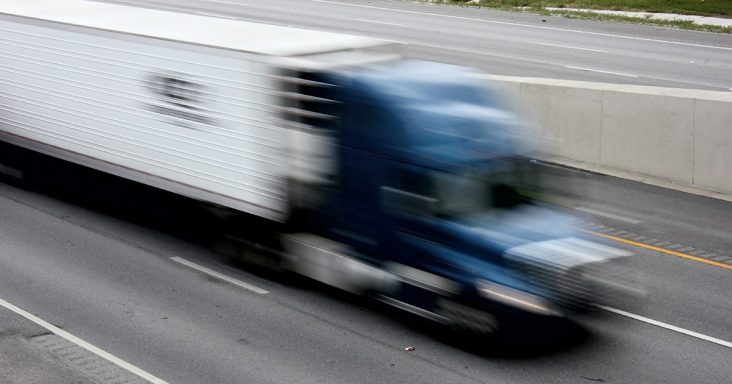Trucking industry strength, improving economic trends tied to COVID-19 pandemic
by February 2, 2021 4:05 pm 1,285 views

The trucking industry, like the overall economy, has “pockets of strength and weakness,” according to an industry economist. Still, the economy is improving and is expected to continue to become better contingent on the COVID-19 pandemic, vaccine efficacy and new stimulus money, an industry economist said.
In a recent Transport Topics webinar, Bob Costello, chief economist for the American Trucking Associations (ATA), said the overall economy is doing better and has benefitted from an approved stimulus package in late December.
He projected that GDP might rise by 2.5% in the first quarter, 3.5% in the second quarter, and between 4% and 4.5% in the second half of the year. He said the projections are based on whether the vaccines work and a new stimulus package is approved. Some concerns for an improving economy include a worsening pandemic, the vaccines aren’t working, or people stop wearing masks.
While the overall economy is recovering, some economy segments are struggling, and freight demand has been mixed as well.
“E-commerce is just crazy right now,” Costello said. Demand also has been strong for temperature-controlled freight for grocery stores and flatbed freight for single-family home construction. But flatbed freight serving some industries, and tank trucks, especially those serving the energy industry, have struggled, he noted.
The economy has “pockets of strength and weakness,” said Costello, adding that the economy is going through a “K-shape recovery,” with parts of the economy doing well while others are not.
“It’s the haves and the have-nots,” he said. The industries in which people gather in large groups are struggling, such as restaurants, travel, professional sports, movies and concerts. At the same time, e-commerce and single-family housing starts have been robust. He said factory output is improving, but it declined by 6.5% in 2020. The sector also has pockets of strength, such as automotive. Meanwhile, he said retail sales, excluding e-commerce, fell by 2.7% in 2020, but e-commerce sales were up more than 20%.
People are purchasing more goods than services, said Costello, noting the importance of extending unemployment benefits. The money will help those who have been laid off because of the pandemic and the economy. He expects another stimulus package but was unsure how large it will be.
Costello expects people to buy fewer goods and more services if people take the vaccines and herd immunity is reached. That would lead to slower growth for goods buying as more people buy services. He said while purchasing the goods has been good for the trucking industry, it’s not expected to last. But this means better times are ahead for the struggling sectors.
Costello said the lack of enough good labor would limit higher GDP growth and lead to regular growth rates of about 2% in the long-term. The trucking industry faces a shortage of drivers that went away at the start of the pandemic but has returned as drivers leave the industry because of the pandemic or cannot work because of violations noted in the Drug and Alcohol Clearinghouse that have prohibited 45,000 drivers from working. Costello said 35,000 of those in the federal database have yet to start the process to return to driving. Also, the new driver pipeline has declined between 30% and 50%, which could affect similarly to the Drug and Alcohol Clearinghouse. Delays in testing for a commercial driver’s license have been an issue as well. Meanwhile, some trucking companies have gone out of business due to rising insurance premiums.
“Even if we all got our vaccinations tomorrow, and we could go back to normal, this is a hole that’s going to take a while to dig out of,” Costello said. “You don’t just add all these drivers overnight. It’s going to take a while. I think this capacity crunch is here to stay for a while, and you’re not going to get out of it by adding enough drivers overnight. As long as the economy doesn’t crater — and we don’t think that’s going to happen, we think the opposite — I think this is something the industry is going to struggle with for a while before we can fix it.”
He also discussed the benefits of infrastructure spending and that it’s “some of the best government spending.” He said the trucking industry spends billions of dollars a year sitting in traffic congestion, and investing in infrastructure will provide efficiencies for years.
In December, the ATA’s advanced seasonally adjusted For-Hire Truck Tonnage Index rose 7.4% after rising by 3.2% in November.
“Tonnage ended last year on a high note,” Costello said. “The index not only registered the largest monthly gain since June, but it also had the first year-over-year increase since March. Freight continues to be helped by strong consumption, retail inventory restocking and robust single-family home construction. With the stimulus checks recently issued and with a strong possibility of more soon, I would expect truck freight to continue rising.”
Compared to December 2019, the index rose 2.3%. For 2020, tonnage declined 3.3%, compared to 2019.
“Because of the pandemic, 2020 was obviously a very challenging year for the economy overall, and that is reflected in the tonnage index’s dip from the previous year,” Costello said. “Despite that, truck tonnage clearly outperformed the broader economy as freight continued to move in the face of a myriad of COVID-related challenges faced by the country.”enges faced by the country.”
